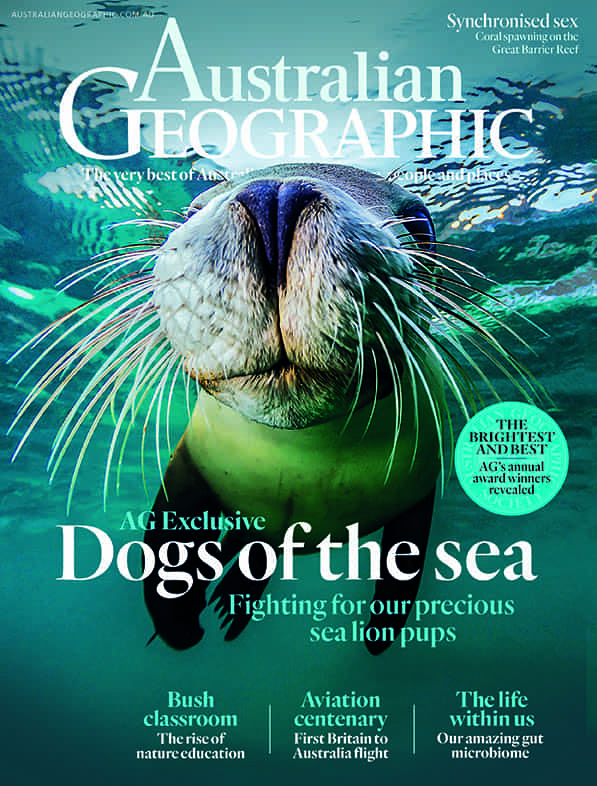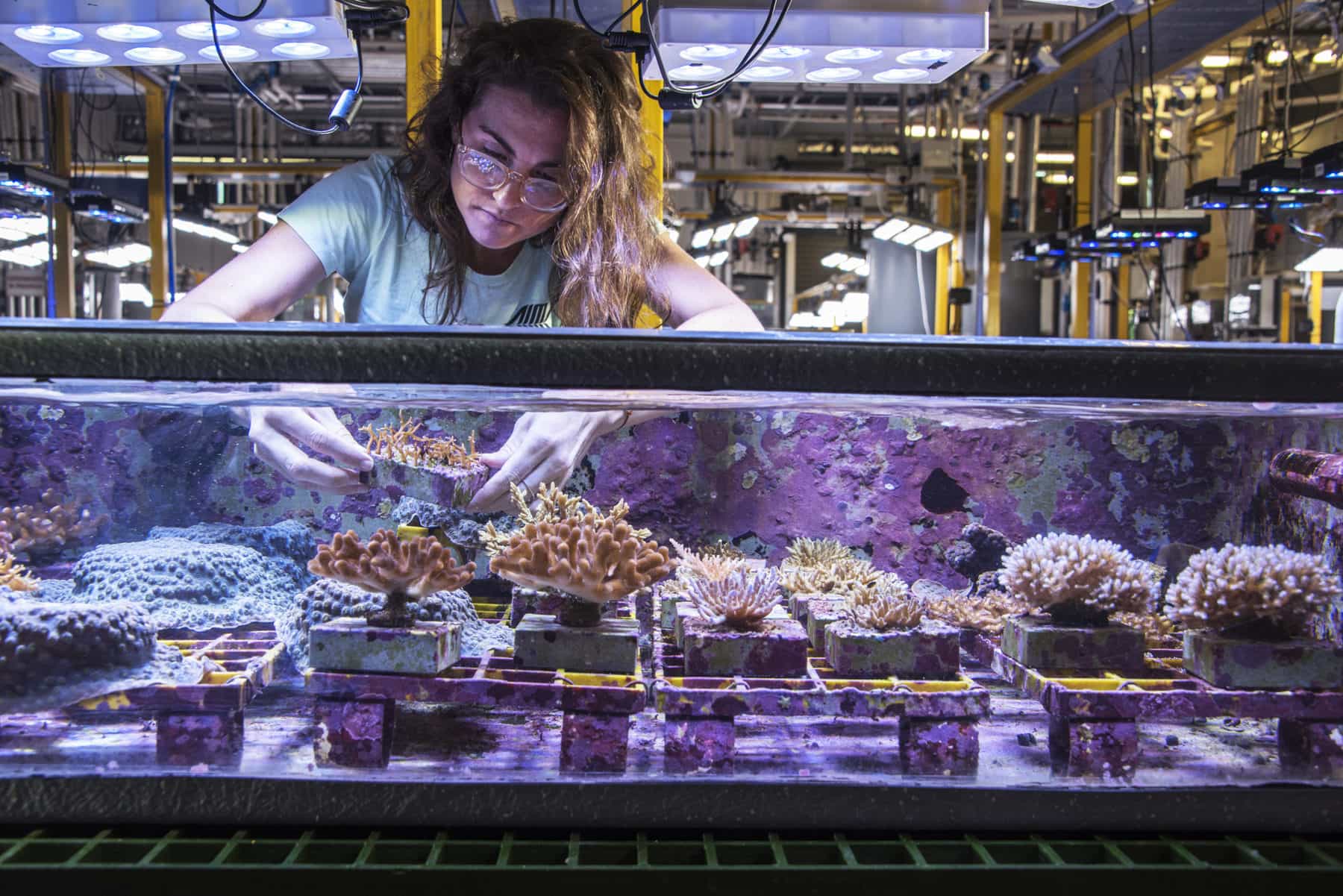EACH YEAR, AFTER a late spring or early summer full moon, a spectacular synchronised coral spawning occurs on the Great Barrier Reef (hereafter the GBR or the Reef). This nocturnal natural phenomenon is like an aquatic fireworks display, as red, yellow and orange bundles of sperm and eggs are released en masse into the ocean.
Most coral species are hermaphrodites – simultaneously both male and female – and typically release tightly packed bundles of sex cells, which open at the ocean’s surface allowing eggs to meet compatible sperm.
During peak spawning, more than 100 species release their sex cells – their gametes – during just a few nights. This phenomenon was first discovered off Townsville in 1984 by a group of young scientists. It was a turning point in their careers and earned them a prestigious Australian Museum Eureka Award for Environmental Research in 1992. They initially documented that 32 coral species had spawned shortly after late spring full moons in 1981 and 1982 at three different locations.
Mass coral spawning is now known to be the most common reproductive mode for the Reef’s corals, and is the culmination of months of development for their sex cells. Timing of the phenomenon is linked to seawater temperature, lunar phases and factors such as the daily cycle of light and dark. In some years, when the full moon falls early in the October–November spawning season, some colonies hold off for a later lunar cycle, resulting in multiple spawning events.
By expelling eggs and sperm at the same time, coral increases opportunities for fertilisation. This mass approach also overwhelms predators: many eggs will be eaten, but at least some will make it through to be fertilised. These develop into mobile larvae that at first move in ocean currents but search out and finally settle on hard substrates in suitable locations to begin growing into new coral colonies.
Mass spawning is believed to have been a critical factor in the Reef achieving its extraordinary size and diversity over many millennia. Now, few of those coral species are able to cope with the rising sea temperatures wrought by human-induced climate change.
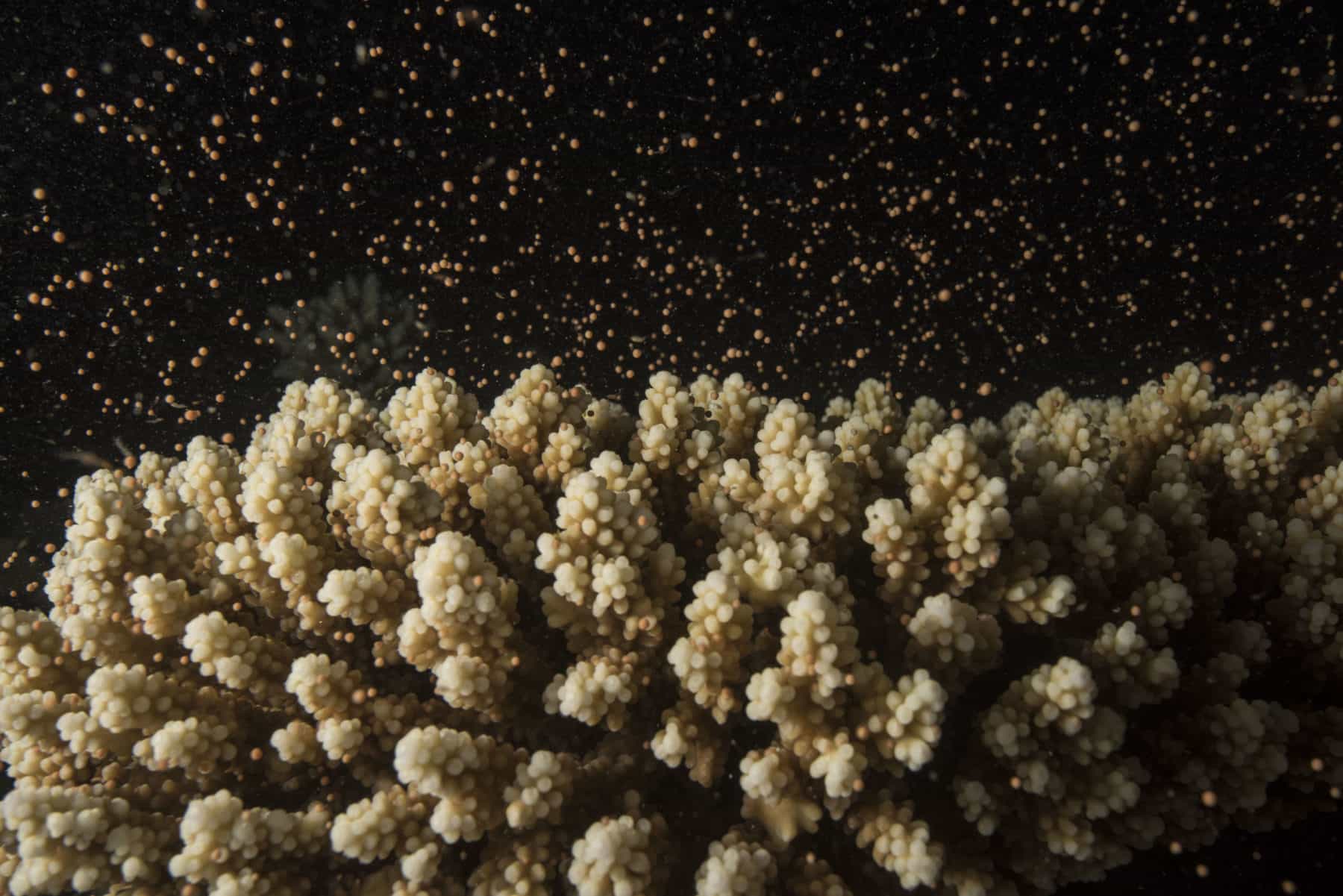
IT’S HARD TO BELIEVE that the humble and diminutive coral polyp could be responsible for creating the largest living structure on the planet, the GBR.
Each tiny polyp has tentacles to feed on plankton, as well as multitudes of tiny algae – called zooxanthellae – living in their tissues. These absorb sunlight to produce oxygen and nutrients, a food source that allows polyps to thrive in the clear, nutrient-poor tropical waters, providing energy to help create their calcium carbonate skeletons that make up the Reef. It’s a critical symbiotic relationship that allows a healthy coral reef to lay down multiple layers, creating those vast structures that teem and pulse with life.
The sprawling coral kingdom of the Reef is framed offshore by the cobalt blue waters of the Coral Sea and inshore by muddy brown coastal waters that are home to deadly jellyfish, saltwater crocodiles and lined with mangrove thickets.
The Reef’s size contributes to its greatness: stretching for 2300km, it covers a total area of 344,400sq.km – and countless photographic opportunities are woven into its inviting patchwork of individual reefs.
Yet scientists now estimate that this thriving marine system, where underwater photographic dreams were once so easily realised, experienced a 50 per cent loss in living coral cover following unprecedented back-to-back mass coral bleaching events in 2016 and 2017.
These events starkly demonstrated that mass bleaching is the greatest threat to the Reef, more than pollution from run-off, coral-eating crown-of-thorns-starfish, coastal development, other pest species or over-fishing. Experts suggest that by 2030, these destructive episodes will occur every year, threatening the Reef further by reducing recovery times. (It’s estimated that an area of reef affected by a mass bleaching event takes about a decade to recover.)
It used to be that when diving on the northern two-thirds of the Reef, the chances of finding patches of thriving coral would be high and you’d have to search hard to find an unhealthy section. Today, that situation is reversed. The GBR Marine Park Authority released a report in August 2019 that downgraded its long-term outlook for the Reef from “poor” in 2014 to “very poor”.
However, in 2017, GBR Legacy, a not-for-profit social enterprise that brings together scientists, educators, communicators and the general public to engage in reef research, identified a site in the worst-affected region that appears to have withstood the worst of the bleaching. The corals at this site are now considered to be resilient ‘super stock’, able to withstand severe heat.
I joined GBR Legacy to journey back to the site in spring 2018. This new organisation’s operating model represents the future of coral reef conservation by providing cost-effective access to the Reef for researchers, and making their findings available to a global audience through effective use of social and more mainstream media such as Australian Geographic, which is an official sponsor.
On board the vessel with me was a research team from the Australian Institute of Marine Science (AIMS) whose aim was to collect coral colonies that had survived mass bleaching for laboratory research back at the National Sea Simulator (SeaSim) in Townsville. Also aboard was Dr John ‘Charlie’ Veron, known as the ‘Godfather of Coral’, who wanted to document hard coral species on a rare section of thriving reef. This football field–sized area of healthy coral has now been named the GBR Legacy Super Site and the second voyage was timed to align with the annual November/December mass spawning event.
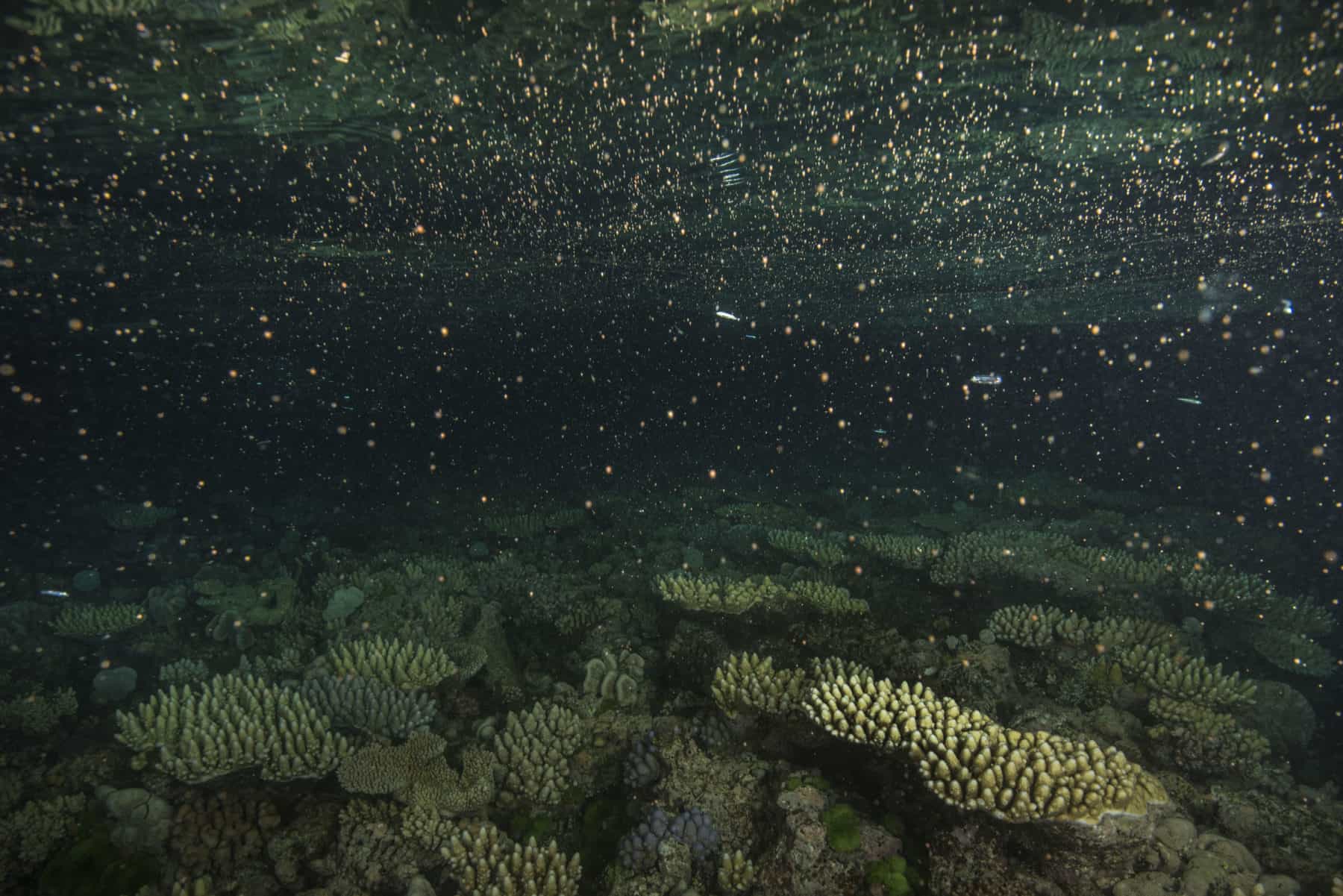
GBR LEGACY’S MANAGING DIRECTOR, John Rumney, is an old hand when it comes to coral spawning. He estimates he has been part of the spawning action on at least 15 occasions and fondly recalls the first time he stumbled across the event by chance in the 1970s.
“We drove the boat through this green, brown and pink swirling slick that was so thick it was hard to see through the water,” John says. “It had an incredibly organic smell, and we hadn’t even heard of coral spawning at the time.”
The annual event has become a family affair for John, who has taken his three daughters snorkelling to experience the spectacle ever since they were pre-teens.
“Under water it’s just something else,” John explains. “It is really a living soup of organic material swarming around and a delicate ballet of coral floating up to the surface.
“It’s not as exciting as being eye to eye with a tiger shark, but it is a real privilege to see nature showing its commitment to the future,” John adds. “This time of year, the other animals are also spawning – fish, sea cucumbers and giant clams.”
John feels he’s one of the luckiest people to have experienced the Reef in its prime. Having spent several years on the Reef as a commercial fisherman and eco-tourism operator, he launched a live-aboard dive vessel called the Undersea Explorer in 1995.
“My wife, Linda, and I started to add research to tourism adventures in the ’80s, so, instead of just hiring a divemaster or instructor we would also get a marine biologist/dive instructor with more hands-on interpretation and education,” John says.
These researchers were able to access areas they couldn’t afford to visit, while the tourists got to share the wonders of the Reef alongside scientific experts. Each trip had a special focus, which ranged from shark tagging, nautilus biology and minke whale ecology to the turtles and tiger sharks of Raine Island. The concept was a critical step towards developing the GBR Legacy model.
When John and Dr Dean Miller, Legacy’s director of science and media, began the project in 2012, they were already concerned about the decline in reef health they had observed. “It went from us trying to have a healthy reef by dealing with things that are manageable in Australia like water quality and fishing, to confronting a huge global CO2 issue – it’s a shame that we now need to save the world to save the Great Barrier Reef and coral reefs worldwide,” Dean says.
John believes there are solutions to this global problem, and that public connection and education are vital to moving forward. It’s important that people still visit the Reef, because there is a commercial advantage in doing so. (Two million tourists visit the reef annually.) It is the Legacy team’s hope to use science, education and multimedia to encourage visitors and their friends to become climate ambassadors, to step up as individuals and connect with other people and get them to respond and act to help save the Reef.
John believes that you don’t have to know everything to start taking steps in the right direction. If there is enough evidence, then you can make a start. “We still have the diversity [of coral] out there,” he says. “We need to protect and learn from it, before it’s too late. If we choose not to act, then we will continue to lose the Reef to a point where it’s unrecognisable.”
Charlie Veron was the first full-time researcher on the GBR and the first scientist employed by AIMS, where he later became chief scientist. He has also discovered and described more than 20 per cent of the world’s coral species.
He first dived the Reef in 1963 at the age 18, off Heron Island. “I remember diving to the bottom of a channel down a wall covered in coral, and I just fell in love with coral reefs then and there,” he says.
“There was so much life – corals, worms, squid, cuttlefish – and I’d never seen anything like it. In the early days, every dive was a new discovery. The Reef was a whole world that only I knew; it was like being the first scientist to walk into a rainforest.”
And yet despite all this beauty, Charlie says his work can be very challenging. “It’s not just swimming along and having a good time,” he explains. “You need to concentrate to identify individual species.”
He was reminded of the challenge while documenting the species diversity at the GBR Legacy Super Site during our expedition, where his key findings included: at least one new species and possibly three; 10 new records for the GBR of species found in the Coral Triangle – an area in the Western Pacific that spans the waters of Indonesia, Malaysia, Papua New Guinea, the Philippines, the Solomon Islands and Timor-Leste; and a coral that has only ever been previously recorded in Sri Lanka. Charlie’s final accounting for the site added up to the greatest diversity of hard coral ever recorded at a single site on the GBR.
This diversity can be attributed to the site’s topography, which encourages habitat diversity, and also its position, which sees it receive currents and water circulation that so far prevent it from being affected by warm water. “If you go almost anywhere in that same region you will come across reef with hardly any coral left,” Charlie says. “There is also an element of luck in its positioning – none of the corals in this area appear sick at all.”
It’s reassuring to now know that the Super Site represents a natural genetic biobank that requires greater investigation and preservation. “I was working in such a small area, with amazing diversity, that was exceptional,” Charlie says. “It’s interesting from an ecological or scientific point of view, but also because it’s surrounded by dying and dead reefs. It’s better than anything I’ve ever seen in recent years. It’s so good to see.”
Charlie acknowledges that without the assistance of GBR Legacy, this site would have remained undiscovered. And although he remains hopeful for the future, he is concerned about the continuing rate of CO2 entering the atmosphere and blames this on emissions from coal-fired power stations. “Coal has powered the industrial revolution and now it is going to power the end of the GBR. This is so serious, and people just don’t seem to understand how serious,” Charlie says.
“I think Australia really needs to make a decision as to whether we are going to continue to export all of this coal and forget the GBR, or protect the GBR. It’s really a political decision, and it’s got to be one or the other and we can’t do both. Australia has now come to the frontline because it is the biggest coal exporter in the world.” (Based on 2018 figures, by US dollar value.)
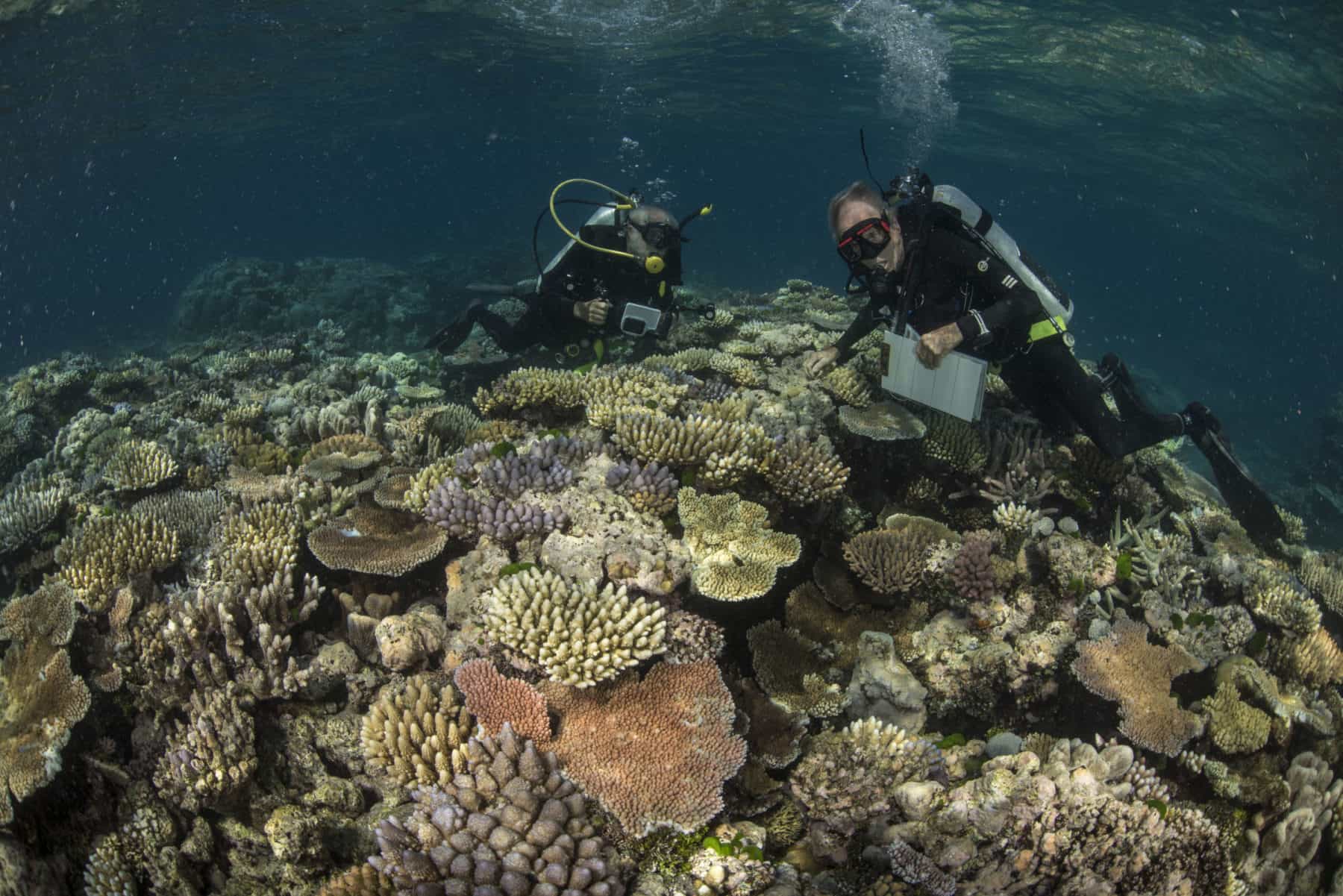
TO STUDY how these resilient corals react to environmental stresses, the AIMS researchers on our expedition take their coral colonies back to Townsville, where they are able to replicate a mass spawning event in the SeaSim research facility. It’s peak spawning season and they need to work through the night to collect bundles of gametes. Many of their experiments will continue for days, weeks and even years to address critical knowledge gaps.
One technique being investigated as a solution to the unfolding crisis is called assisted gene flow. This technique proposes moving warm-adapted more northerly corals to cooler parts of the Reef further south with the aim of improving the heat tolerance of at-risk corals and building in climate resilience to the resulting offspring.
For many of the experiments it’s the first time the feasibility of the technique has been undertaken on the GBR. Once the offspring are placed on the Reef, field tests will add to the results from experiments in the SeaSim, which have already shown that juvenile corals with at least one parent from the northern GBR are significantly more likely to survive high temperatures.
“We are trying to figure out ways to increase the options in our toolbox for different restoration methods that can be deployed if we start to see more mass bleaching,” says Dr Kate Quigley, an AIMS researcher who used samples from the expedition.
“The whole idea of the symbiosis between corals and the symbiont algae (zooxanthellae) is what drew me to the Reef,” Kate says. “It’s fascinating that one organism can live inside another and just be so important to the functioning of such a huge ecosystem – it’s all based on this little cell that lives inside the coral that [makes the entire reef] exist.”
Kate and the team at AIMS are working to manipulate the host genetic background of corals through selective breeding, to try and optimise the combination of host genetics and create a coral that can better survive heat. At the same time, the team is also trying to encourage the coral to take up symbiont algae that are more heat tolerant, which they are also breeding at AIMS. “We are really interested in the genetics of the baby corals, but we are also interested in the composition of the symbionts as well as their genetics, so we are looking at this from multiple angles,” Kate says.
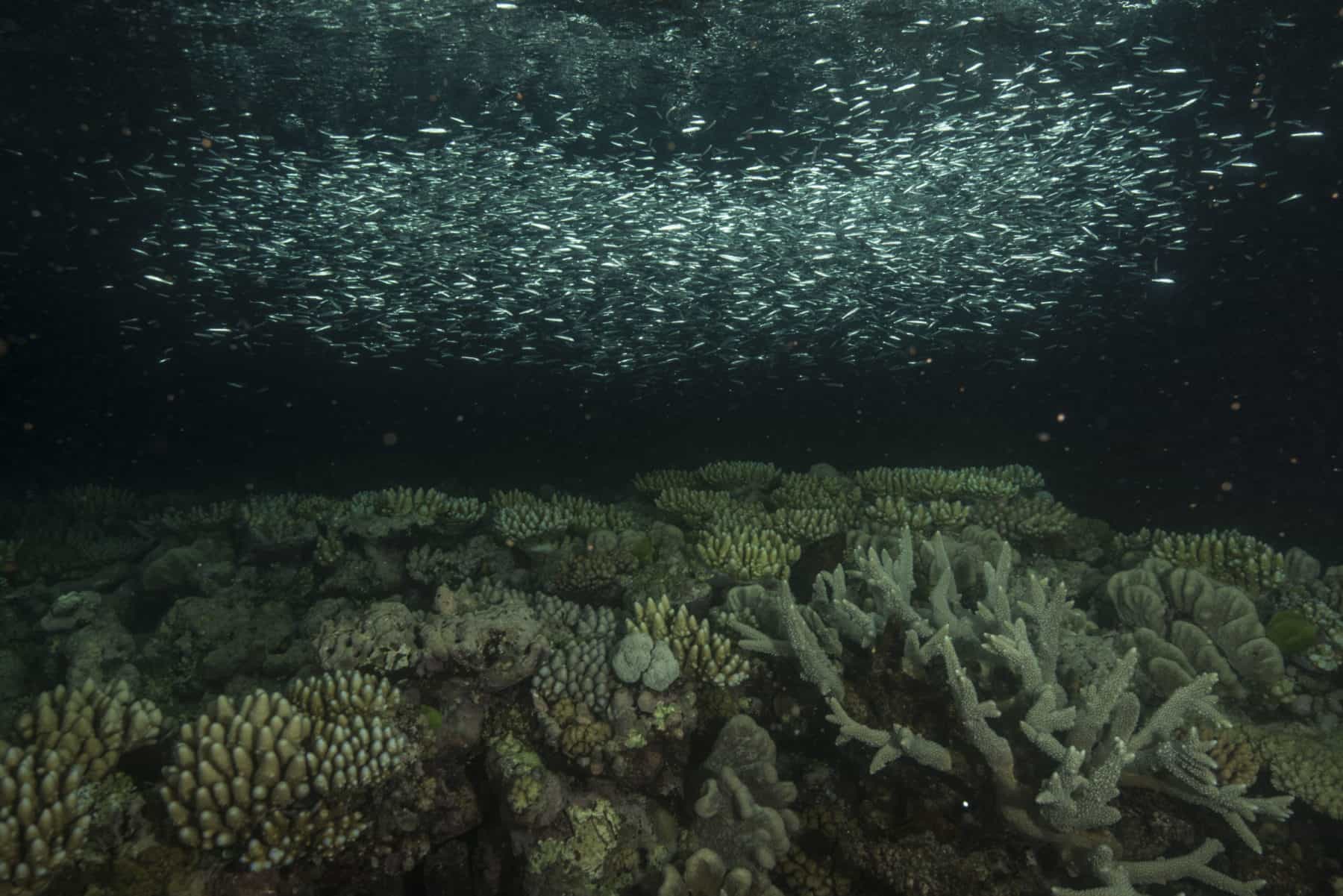
FOLLOWING THE BUSY spawning period, and after the GBR Legacy expedition returned to shore, Professor Terry Hughes and his team at the ARC Centre of Excellence for Coral Reef Studies conducted investigations into the success of the 2018 coral spawning event.
They measured rates of coral recruitment by attaching small clay tiles to the Reef just before the predicted mass spawning events over the past several years. The settlement panels represent a standardised section of habitat and allow for improved detection of the coral recruits, which are just 1–2mm in size.
Almost 1000 tiles were deployed across 17 widely separated reefs after the 2017 and 2018 mass bleachings. After eight weeks they were collected and carefully inspected under a microscope to count the number of newly settled coral recruits. The team measured the arrival rate of babies, which is something they had done many times before the bleaching. Their results showed that in 2018 the average recruitment by baby corals had declined by 89 per cent when compared with previous years.
When corals reproduce they do so in two major ways: they can be brooders, which release larvae that are large and well developed and settle on the same reef that produced them. They don’t move far and they settle within a day. Then there are the mass spawning corals, from which larvae typically don’t settle for 4–7 days.
Historically, a week is a significant window of time for larvae to be transported on currents from one reef to the next, and mass spawning corals are the source of most larvae on the Reef.
“For the first time, in 2018 the brooders made up the majority,” Terry says. “This means the way the GBR is connected has changed profoundly, and that is important because when a reef is damaged, the repair of that reef depends on the delivery or arrival of baby corals from somewhere else.”
Terry compares the damage with a cyclone track that is 50–100km wide. On either side of that trail of damage is reef that can supply the next generation of corals. But with an impact area of 1500km caused by bleaching, spawning corals don’t have the ability to reach much of the damaged area.
“There are now fewer connections and more small connections,” Terry says. “We are also able to explain the decrease in recruitment by the babies in terms of how much adult brood stock was lost. Parts of the Reef that had big losses of adult brood stock had the biggest decreases in recruitment.”
The team found that in the southern GBR, where the adult coral cover had actually gone up, so did recruitment.
“Unfortunately, we didn’t find any evidence that the undamaged southern Reef is capable of delivering larvae to the middle or northern GBR. The distance is just too great, and the current goes the wrong way,” Terry says.
In order for replenishment rates to recover back to their normal levels, the Reef is going to need more adults, which is going to take time. “It will take 5–10 years for the lost adults to be replaced by corals that are now juveniles, and that 10 years is likely going to be interrupted by a fifth bleaching event,” Terry says.
The Reef today is behaving fundamentally differently from the way it did a few years ago. The mix of species has changed and the way it is interconnected has changed. The composition of the coral larvae, which drive the recovery trajectory, is altered, so fundamental processes have changed.
Terry says it is the 50 billion surviving corals that are critical to the Reef’s survival and suggests that we should be focusing on securing their future.
“We have to relearn how the system is now working,” he says. “It is a huge research challenge for the next generation of marine scientists. Many of my students have had to redesign their projects because their corals died, but I tell them to hang in there because there has never been a greater need for coral reef researchers.
“The GBR is in the poorest condition we have measured: coral cover is the lowest we have ever seen, coral recruitment is the lowest we have ever seen, and the Reef needs help,” Terry says. “But, there are 50 billion survivors still out there; we need to look after them and the only way to do that in the longer term is for Australia to stop beating about the bush and deal with rising emissions.”
In the meantime, scientists and reef experts will continue their work to protect and restore this natural wonder, supported by expedition teams such as those of GBR Legacy.
“I’m trying to stay positive,” says Legacy’s John Rumney. “It was really humbling to see the mass spawning last year, and I anticipate more success this year with the Reef rebounding back after a cool winter with little heat stress,” he says.
“Although my grandchildren will never see what I’ve seen on the Reef, I hope they still see enough to make them wonder and dream – the dance of life on the Great Barrier Reef is simply magical.”
This article is featured in Issue 153 of Australian Geographic. Purchase your copy here.
